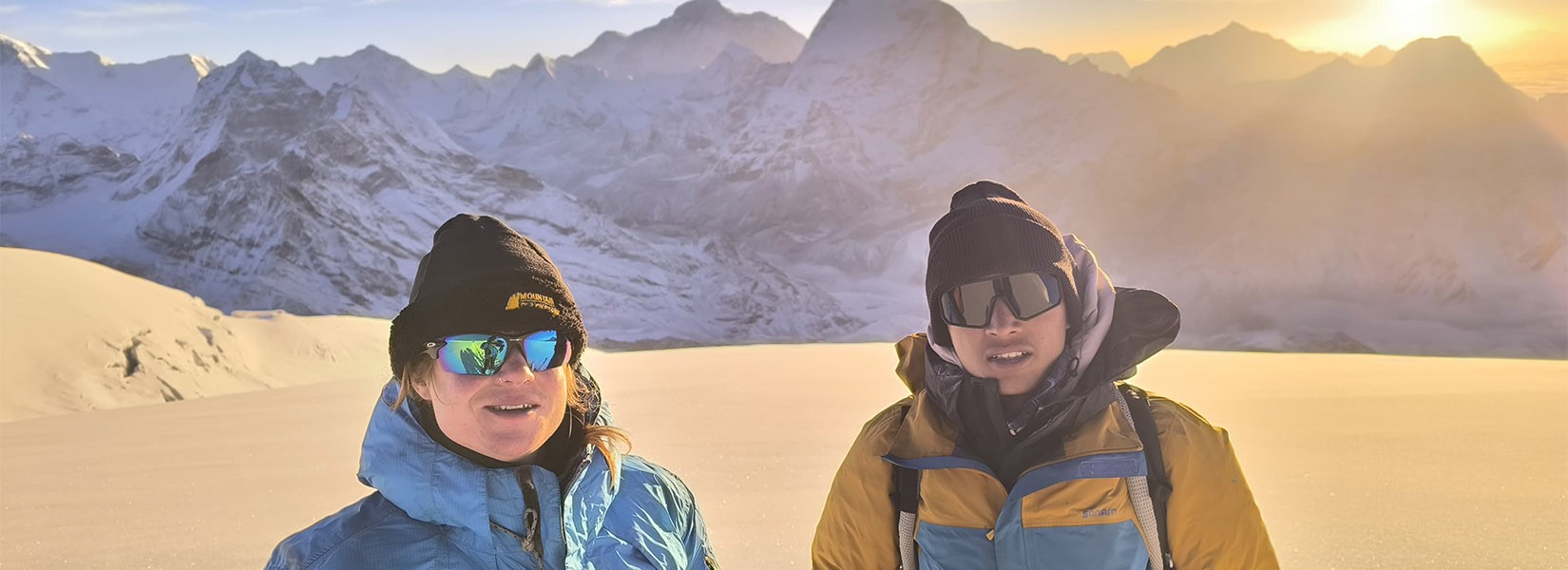Highlights
Thrilling scenic flight from Kathmandu to Lukla
Trek through Sagarmatha National Park’s lush forests and suspension bridges
Experience Sherpa culture in remote Himalayan villages
Visit the sacred Tengboche Monastery, the spiritual heart of Khumbu
Explore Everest Base Camp and hike to Kala Patthar for a majestic sunrise view
Learn basic mountaineering techniques with professional Sherpa guides
Summit Island Peak (6,189m), a perfect first Himalayan climb
Enjoy panoramic views of Everest, Lhotse, Nuptse, Makalu, Ama Dablam, and more
About Island Peak Climbing
Island Peak Climbing (Imja Tse) is one of Nepal’s most popular trekking peaks, standing proudly in the heart of the Everest region. Rising 6,189 meters above sea level, this expedition perfectly combines classic trekking with real mountaineering experience—making it ideal for ambitious trekkers aiming for their first Himalayan summit.
The climb begins with the legendary Everest Base Camp trail, passing through iconic Sherpa settlements, prayer-flag-lined bridges, and lush rhododendron forests. Along the way, you’ll explore Everest Base Camp itself and ascend to Kala Patthar (5,545m) for unmatched sunrise views over Mount Everest.
From there, the adventure continues into the stunning Chhukung Valley before approaching Island Peak Base Camp, where climbers receive practical training in using crampons, ice axes, ropes, and ladders. Despite being physically demanding, Island Peak is not overly technical—perfect for well-prepared trekkers seeking their first Himalayan summit.
First climbed by Tenzing Norgay and Edmund Hillary’s team in 1953 as a warm-up for Everest, Island Peak remains a classic training and adventure climb. The peak was aptly named by Eric Shipton’s 1951 expedition, as it appears like an island rising from a sea of ice when viewed from Dingboche.
Our 19-Day Island Peak Climbing itinerary by Hikers Haven is designed with proper acclimatization, cultural exploration, and safety in mind—ensuring you not only reach the summit but also enjoy every step of the journey.
Tips & Ideas
Difficulty & Fitness
Island Peak (Imja Tse) is a strenuous climb that requires excellent physical fitness and previous trekking experience. Basic rope and crampon use are taught at base camp. The climb is more demanding than technical.
Best Seasons
Spring (March–May) – clear skies, stable weather, blooming rhododendrons.
Autumn (September–November) – crisp air, clear mountain views, ideal climbing conditions.
Accommodation & Meals
Kathmandu: 3-star hotel with breakfast.
Trek: Teahouses/lodges (twin sharing).
Climb: Tented camps at Base & High Camp (all meals included).
Transportation
Electricity & Charging
Available in most lodges for a small fee. Solar power is used at higher altitudes—carry extra batteries or a solar charger.
Guides & Support Crew
Professional Sherpa climbing guides, assistant guides, and porters ensure safety and comfort. One porter for every two trekkers (20–22 kg max per porter).
Insurance & Rescue
Comprehensive travel insurance is mandatory, covering high-altitude rescue and medical evacuation.
Tipping
Tipping is customary and appreciated:
Why Climb Island Peak with Hikers Haven?
Licensed, experienced climbing guides with successful summit records
Safety-first approach with acclimatization schedule
Seamless logistics, quality equipment, and ethical trekking practices
Personalized service for small groups
Recommended Gear (Essentials)
Passport + travel insurance papers + permits copy
Functional insulated down jacket (warm), base layers, fleece layers
Mountaineering boots (double or single w/ crampon compatibility)
Crampons, climbing harness, helmet (we provide or arrange on request)
Ice axe, trekking poles, gaiters
4-season sleeping bag (rated to -15°C / -20°C for summit nights)
Headlamp + spare batteries, sunglasses (UV 100%), sunscreen
Personal medications, water purification tablets, blister care
Daypack (20–30L) + duffel bag (provided for porters)
(We can supply rental gear — mention requirements in advance.)
Frequently Asked Questions
Q: Do I need previous climbing experience?
A: No technical prior experience is required, but you should have prior multi-day trekking experience and excellent fitness. Our guides provide technical training at Base Camp.
Q: Is Island Peak technically difficult?
A: Island Peak is considered non-technical to moderately technical: the summit involves glacier travel, ladder crossings, and fixed ropes on steep snow. The hardest section is the headwall below the summit. Proper instruction and guide support make the route manageable for fit trekkers.
Q: What’s the success rate / best time?
A: Best success seasons are spring and autumn. Success depends on weather, acclimatisation, and individual fitness.
Q: What about altitude sickness?
A: AMS is a real risk. We include acclimatisation days (Namche, Dingboche) and monitor clients closely. Hydrate, ascend slowly, and carry Diamox if advised by your physician.
Q: Do you provide oxygen or supplementary systems?
A: Standard program does not include supplementary oxygen. If needed due to medical reasons, we can advise and arrange emergency evacuation.
